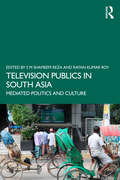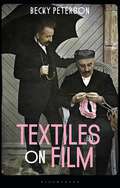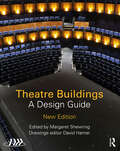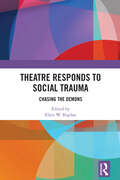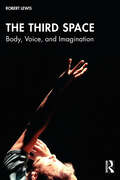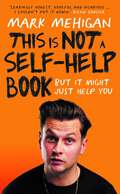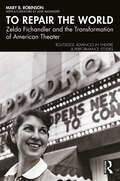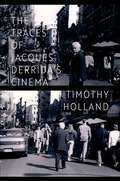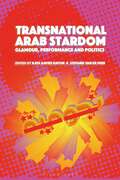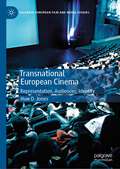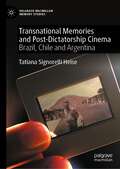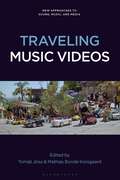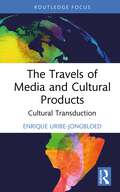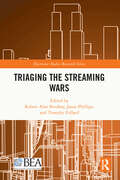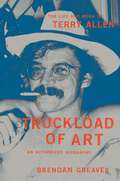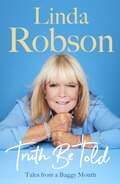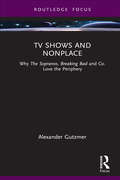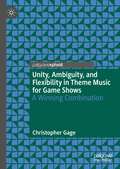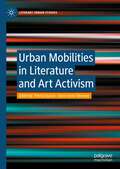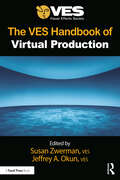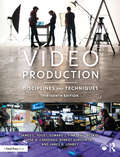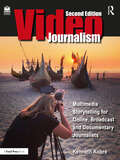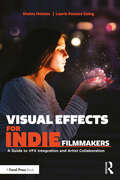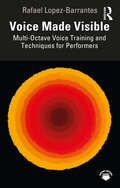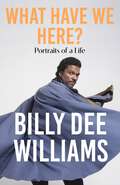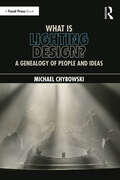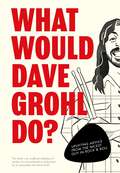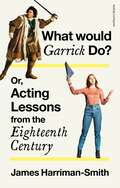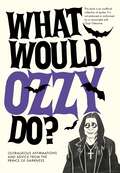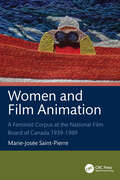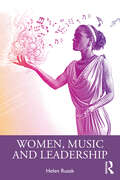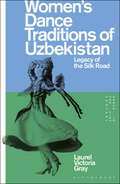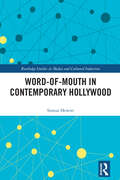- Table View
- List View
Television Publics in South Asia: Mediated Politics and Culture
by S.M. Shameem Reza and Ratan Kumar RoyTelevision has a prime role to play in the formation of discursive domains in the everyday life of South Asian publics. This book explores various television media practices, social processes, mediated political experiences and everyday cultural compositions from Afghanistan, Bangladesh, India, Nepal, Pakistan and Sri Lanka. With the help of country specific case studies, it captures broad range of themes which foreground the publics and their real-life experiences of television in the region. The essays in this book discuss gendered television spaces; women seeking solace from television in pandemic; the taboo in digital tv dramas; television viewership and localizing publics; changing viewership from television to OTT; news and public perception of death; re-defining ‘the national’; theatrical television; and post truth television news, among other key issues. Rich in ethnographic case studies, this volume will be a useful resource for scholars and researchers of media and communication studies, journalism, digital media, South Asian studies, cultural studies, sociology and social anthropology.
Television Publics in South Asia: Mediated Politics and Culture
Television has a prime role to play in the formation of discursive domains in the everyday life of South Asian publics. This book explores various television media practices, social processes, mediated political experiences and everyday cultural compositions from Afghanistan, Bangladesh, India, Nepal, Pakistan and Sri Lanka. With the help of country specific case studies, it captures broad range of themes which foreground the publics and their real-life experiences of television in the region. The essays in this book discuss gendered television spaces; women seeking solace from television in pandemic; the taboo in digital tv dramas; television viewership and localizing publics; changing viewership from television to OTT; news and public perception of death; re-defining ‘the national’; theatrical television; and post truth television news, among other key issues. Rich in ethnographic case studies, this volume will be a useful resource for scholars and researchers of media and communication studies, journalism, digital media, South Asian studies, cultural studies, sociology and social anthropology.
Textiles on Film
by Becky PetersonThe imagined worlds of the cinematic mise-en-scène are rich with textiles: fabrics drape over sets, serve as props, and develop mood and character as dress and décor. A much-needed examination of the cultural and emotional impact of textiles as mediated through cinematic technology, Textiles on Film broadens our understanding of the dynamic relationship between fabric and film.Drawing on scholarship across multiple disciplines and exploring a wide range of films-from lesser-known avant-garde films to big-budget Hollywood productions-this book will inspire scholars and students of film, fashion, and textiles. Close readings of on-screen textiles redirect meaning to that which is often overlooked, including depictions of gender expression, behind-the-scenes labor, and architectural and bodily ornamentation. Attentive to the social nuances of fabrics from polyester to velvet, and to the physical qualities of the textiles themselves, Becky Peterson unearths new possibilities for reading media and textile cultures.
Theatre Buildings: A Design Guide
by Association of British Theatre Technicians (ABTT) Margaret ShewringIn 2021, its Diamond Jubilee year, the Association of British Theatre Technicians (ABTT) undertook to revise Theatre Buildings: A Design Guide (Routledge, 2010). This new edition (Routledge, 2023) has substantially re-written text with fresh images and entirely new reference projects, providing essential guidance for all those engaged in the design of theatre buildings. Edited by Margaret Shewring (Emeritus Reader, University of Warwick, former Director of the Postgraduate Diploma and MA in Theatre Consultancy), this new publication is written by a team of international experts, architects, theatre consultants, acousticians, engineers and industry professionals led by Tim Foster (Foster Wilson Size) and Robin Townley (CEO of the ABTT). It provides an invaluable resource for those looking to build, remodel or conserve theatre buildings, taking into account the significant changes which have taken place in the last twelve years in all aspects of theatre design and technical practice. It locates those changes in the wider context of the need for sustainability in the theatre industry in response to the climate emergency, inclusivity, diversity of access, placemaking and concerns for health and wellbeing. This new edition provides guidance for anyone who seeks inspiration and encouragement to create or improve a place of entertainment or who seeks to understand what might be required to accommodate an audience for the presentation of live performance and the successful use, operation and organisation of such a venue. Its generous format and the thirty-two new reference projects, more than 260 high-resolution colour images and 175 diagrams and specially commissioned plans make it accessible and informative both to the general reader and the professional specialist.
Theatre Buildings: A Design Guide
by Margaret Shewring David HamerIn 2021, its Diamond Jubilee year, the Association of British Theatre Technicians (ABTT) undertook to revise Theatre Buildings: A Design Guide (Routledge, 2010). This new edition (Routledge, 2023) has substantially re-written text with fresh images and entirely new reference projects, providing essential guidance for all those engaged in the design of theatre buildings. Edited by Margaret Shewring (Emeritus Reader, University of Warwick, former Director of the Postgraduate Diploma and MA in Theatre Consultancy), this new publication is written by a team of international experts, architects, theatre consultants, acousticians, engineers and industry professionals led by Tim Foster (Foster Wilson Size) and Robin Townley (CEO of the ABTT). It provides an invaluable resource for those looking to build, remodel or conserve theatre buildings, taking into account the significant changes which have taken place in the last twelve years in all aspects of theatre design and technical practice. It locates those changes in the wider context of the need for sustainability in the theatre industry in response to the climate emergency, inclusivity, diversity of access, placemaking and concerns for health and wellbeing. This new edition provides guidance for anyone who seeks inspiration and encouragement to create or improve a place of entertainment or who seeks to understand what might be required to accommodate an audience for the presentation of live performance and the successful use, operation and organisation of such a venue. Its generous format and the thirty-two new reference projects, more than 260 high-resolution colour images and 175 diagrams and specially commissioned plans make it accessible and informative both to the general reader and the professional specialist.
Theatre Responds to Social Trauma: Chasing the Demons (Routledge Series in Equity, Diversity, and Inclusion in Theatre and Performance)
This book is a collection of chapters by playwrights, directors, devisers, scholars, and educators whose praxis involves representing, theorizing, and performing social trauma.Chapters explore how psychic catastrophes and ruptures are often embedded in social systems of oppression and forged in zones of conflict within and across national borders. Through multiple lenses and diverse approaches, the authors examine the connections between collective trauma, social identity, and personal struggle. We look at the generational transmission of trauma, socially induced pathologies, and societal re-inscriptions of trauma, from mass incarceration to war-induced psychoses, from gendered violence through racist practices. Collective trauma may shape, protect, and preserve group identity, promoting a sense of cohesion and meaning, even as it shakes individuals through pain. Engaging with communities under significant stress through artistic practice offers a path towards reconstructing the meaning(s) of social trauma, making sense of the past, understanding the present, and re-visioning the future.The chapters combine theoretical and practical work, exploring the conceptual foundations and the artists’ processes as they interrogate the intersections of personal grief and communal mourning, through drama, poetry, and embodied performance.
Theatre Responds to Social Trauma: Chasing the Demons (Routledge Series in Equity, Diversity, and Inclusion in Theatre and Performance)
by Ellen W. KaplanThis book is a collection of chapters by playwrights, directors, devisers, scholars, and educators whose praxis involves representing, theorizing, and performing social trauma.Chapters explore how psychic catastrophes and ruptures are often embedded in social systems of oppression and forged in zones of conflict within and across national borders. Through multiple lenses and diverse approaches, the authors examine the connections between collective trauma, social identity, and personal struggle. We look at the generational transmission of trauma, socially induced pathologies, and societal re-inscriptions of trauma, from mass incarceration to war-induced psychoses, from gendered violence through racist practices. Collective trauma may shape, protect, and preserve group identity, promoting a sense of cohesion and meaning, even as it shakes individuals through pain. Engaging with communities under significant stress through artistic practice offers a path towards reconstructing the meaning(s) of social trauma, making sense of the past, understanding the present, and re-visioning the future.The chapters combine theoretical and practical work, exploring the conceptual foundations and the artists’ processes as they interrogate the intersections of personal grief and communal mourning, through drama, poetry, and embodied performance.
The Third Space: Body, Voice, and Imagination
by Robert LewisThe Third Space serves a crucial need for contemporary performers by providing an interdisciplinary and physiovocal approach to training. It is a new take on body and voice integration designed to develop the holistic performer. It takes performers through a series of step-by-step practical physiovocal exercises that connects the actor’s centre to the outside world, which increases awareness of self and space. It also develops a deeper connection between spaces within the body and the environment by connecting sound, imagination, and movement.Robert Lewis’s approach is a way of working that unlocks the imagination as well as connecting performers to self, space, and imagination, through voice and body. It conditions, controls, and engages performers by integrating various voice and movement practices.The theories and practice are balanced throughout by: introducing the practical works theoretical underpinnings through research, related work, and case studies of performances; demonstrating a full program of exercises that helps performers get in touch with their centre, their space, and shape both within and outside the body; and exploring the performers physiovocal instrument and its connection with imagination, energies, and dynamics. This book is the result of nearly 20 years of research and practice working with voice and movement practitioners across the globe to develop training that produces performers that are physiovocally ready to work in theatre, screen, and emergent technologies.
The Third Space: Body, Voice, and Imagination
by Robert LewisThe Third Space serves a crucial need for contemporary performers by providing an interdisciplinary and physiovocal approach to training. It is a new take on body and voice integration designed to develop the holistic performer. It takes performers through a series of step-by-step practical physiovocal exercises that connects the actor’s centre to the outside world, which increases awareness of self and space. It also develops a deeper connection between spaces within the body and the environment by connecting sound, imagination, and movement.Robert Lewis’s approach is a way of working that unlocks the imagination as well as connecting performers to self, space, and imagination, through voice and body. It conditions, controls, and engages performers by integrating various voice and movement practices.The theories and practice are balanced throughout by: introducing the practical works theoretical underpinnings through research, related work, and case studies of performances; demonstrating a full program of exercises that helps performers get in touch with their centre, their space, and shape both within and outside the body; and exploring the performers physiovocal instrument and its connection with imagination, energies, and dynamics. This book is the result of nearly 20 years of research and practice working with voice and movement practitioners across the globe to develop training that produces performers that are physiovocally ready to work in theatre, screen, and emergent technologies.
This is Not a Self-Help Book
by Mark MehiganMuch of Mark Mehigan's twenties read like a how-to manual: How to get very drunk without raising people's suspicions you might be an alcoholic. Outwardly successful, inside he was drowning. Nearing 30, he was hurtling towards a nervous breakdown and using payday loans to fund a burgeoning cocaine habit. His only choice was to finally relinquish control and ask for help. In doing so he discovered a life beyond his wildest dreams. This new way of life embraced letting stuff go. Giving things up. He discovered the power of rigorous honesty, how to live without relying on destructive behavioural patterns and the joy of letting people in instead of keeping them out. Mark's story is one of recovery and sobriety. It brilliantly articulates the societal pressures that can leave people feeling isolated and lost, and offers a path to finding your own sense of 'good enough'. Perhaps Mark's story can be the spark that ignites that journey for you, or at the very least a guide on how not to mess up your life. Either way, it's definitely not a self-help book.
To Repair the World: Zelda Fichandler and the Transformation of American Theater (ISSN)
by Mary B. RobinsonThis book is a biography in the form of an oral history about a woman whose founding of Arena Stage in Washington, DC in 1950 shifted live professional theater away from Broadway and inspired the creation of non-profit theaters around the country. Dianne Wiest, James Earl Jones, Stacy Keach, and Jane Alexander, among many others, share their memories of this intrepid pioneering woman during Arena Stage’s early years.As Head of New York University’s Graduate Acting Program for 25 years, Zelda Fichandler also trained a younger generation of gifted actors. Marcia Gay Harden, Rainn Wilson, Mahershala Ali, and other developing actors who became “artist-citizens” under her guidance, talk about the ways in which she transformed their lives.Theater practitioners who have lived during Zelda Fichandler’s time will find this book a fascinating and entertaining read––as will all theater lovers, especially those in Washington, DC. And through this vivid and compelling oral history, students and aspiring artists will come to grasp how the theatrical past can shed essential light on the theater of today and tomorrow.
To Repair the World: Zelda Fichandler and the Transformation of American Theater (ISSN)
by Mary B. RobinsonThis book is a biography in the form of an oral history about a woman whose founding of Arena Stage in Washington, DC in 1950 shifted live professional theater away from Broadway and inspired the creation of non-profit theaters around the country. Dianne Wiest, James Earl Jones, Stacy Keach, and Jane Alexander, among many others, share their memories of this intrepid pioneering woman during Arena Stage’s early years.As Head of New York University’s Graduate Acting Program for 25 years, Zelda Fichandler also trained a younger generation of gifted actors. Marcia Gay Harden, Rainn Wilson, Mahershala Ali, and other developing actors who became “artist-citizens” under her guidance, talk about the ways in which she transformed their lives.Theater practitioners who have lived during Zelda Fichandler’s time will find this book a fascinating and entertaining read––as will all theater lovers, especially those in Washington, DC. And through this vivid and compelling oral history, students and aspiring artists will come to grasp how the theatrical past can shed essential light on the theater of today and tomorrow.
The Traces of Jacques Derrida's Cinema
by Timothy HollandSituated at the intersection of film and media studies, literary theory, and continental philosophy, The Traces of Jacques Derrida's Cinema provides a trenchant account of the role of cinema in the oeuvre of one of the most influential philosophers of the twentieth century, Jacques Derrida (1930-2004). The book is animated by Derrida's self-confessed passion for the movies, his reluctance to write about film despite the range of his corpus, and the generative encounters arising between his legacy and the field of film and media studies as a result. Given the expanse of its references, interdisciplinarity, and consideration of Derrida's approach to the experience of both spectatorship and the act of being filmed, The Traces of Jacques Derrida's Cinema contributes to the ongoing close analyses of the philosopher's work while also providing a rigorous introduction to deconstruction. Author Timothy Holland interweaves historical and speculative modes of research and writing to articulate the peripheral-yet surprisingly crucial-place of the cinematic medium for Derrida and his philosophical enterprise. The outcome is a meticulously detailed survey of the centers and margins of Derrida's oeuvre that include forays into such terrain as: his notable appearances in films; an unrealized project on cinema and belief that Derrida proposed in a 2001 interview; the correspondences between the strategies of deconstruction and the traditions, homecomings, and wordplay of David Lynch's cinematic media; and the questions wedded to the future of film studies amid the vicissitudes of the modern, virtual university. Ultimately, Holland pursues the thinking activated by the flickering of Derrida's cinema-not only the absence and presence of film in Derrida's professional and personal life, but also the rigor of academic discourse and the pleasures of the movies, ghosts and technology, religious faith and scientific knowledge, and ruination and survival-as a critical chance for reflection.
Transnational Arab Stardom: Glamour, Performance and Politics
by Kaya Davies HayonBuilding on the work of star studies scholars, this collection provides contextual analyses of off-screen representation, as well as close textual analyses of films and star personas, thereby offering an in-depth study of the Arab star as text and context of Arab cinema. Using the tools of audience reception studies, the collection will also look at how stars (of film, stage, screen and new media) are viewed and received in different cultural contexts, both within and outside of the Arabic-speaking world.Arab cinema is often discussed in terms of political representation and independent art film, but rarely in terms of stardom, glamour, performance or masquerade. Aside from a few individual studies on female stardom or aspects of Arab masculinity, no major English-language study on Arab stardom exists, and collections on transnational stars or world cinema also often neglect to include Arab performers. This new book seeks to address this gap by providing the first study dedicated entirely to stardom on the Arab screen.Structured chronologically and thematically, this collection highlights and explores Arab film, screen and music stars through a transnational and interdisciplinary set of contributions that draw on feminist, performance and film theories, media studies, sound studies, material culture, queer star and celebrity studies, and social media studies.
Transnational European Cinema: Representation, Audiences, Identity (Palgrave European Film and Media Studies)
by Huw D. JonesThis book explores how audiences in contemporary Europe engage with films from other European countries. It draws on admissions data, surveys, and focus group discussions from across the continent to explain why viewers are attracted to particular European films, nationalities, and genres, including action-adventures, family films, animations, biopics, period dramas, thrillers, comedies, contemporary drama, and romance. It also examines how these films are financed, produced, and distributed, how they represent Europe and other Europeans, and how they affect audiences. Case-studies range from mainstream movies like Skyfall, Taken, Asterix & Obelix: God Save Britannia, and Sammy’s Adventures: A Turtle’s Tale to more middlebrow and arthouse titles, such as The Lives of Others, Volver, Coco Before Chanel, The Girl with the Dragon Tattoo, Intouchables, The Angels’ Share, Ida, The Hunt, and Blue Is the Warmest Colour. The study shows that watching European films can sometimes improve people’s understandings of other countries and make them feel more European. However, this is limited by the strong preference for Anglo-American action-adventures that offer few insights into the realities of European life. While some popular European arthouse films explore a wider range of nationalities, social issues, and historical events, these mainly appeal to urban-dwelling graduates. They can also sometimes accentuate tensions between Europeans instead of bringing them together. The book discusses what these findings mean for the European film industry, audiovisual policy, and scholarship on transnational and European cinema. It also considers how surveys, focus groups, databases and other methods that go beyond traditional textual analysis can offer new insights into our understanding of film.
Transnational Memories and Post-Dictatorship Cinema: Brazil, Chile and Argentina (Palgrave Macmillan Memory Studies)
by Tatiana Signorelli HeiseThis book investigates the role that cinemas in Brazil, Chile and Argentina have played in reconstructing memories of the most recent military dictatorships. These countries have undergone a distinctive post-dictatorship experience marked by unprecedented debates about human rights violations, the silencing of victims and accountability for state crimes. Meanwhile, politically committed filmmakers have created an extensive body of work addressing the dictatorship and its aftermath. This book employs a transnational and comparative approach to examine the strategies that these filmmakers have used to render visible what has remained hidden, to make reappear what has disappeared, and to reinterpret historical actors and events from a contemporary perspective. Through attention to the specific properties of the medium and the socio-historical context in which films have been made, it describes the different cinematic modes of remembering that emerged in response to wider memory frameworks in South America.
Traveling Music Videos (New Approaches to Sound, Music, and Media)
by Tomáš Jirsa and Mathias Bonde KorsgaardTraveling Music Videos offers a new interdisciplinary perspective on how contemporary music videos travel across, shape, and transform various media, online platforms, art institutions, and cultural industries worldwide. With the onset of digital technologies and the proliferation of global video-sharing websites at the beginning of the 21st century, music video migrated from TV screens to turn instead to the internet, galleries, concert stages, and social media. As a result, its aesthetics, technological groundings, and politics have been radically transformed. From the kinaesthetic experience of TikTok to the recent reimaginations of maps and navigation tools through music video cartographies, from the ecofeminist voices mediated by live-stream concerts to the transmedia logic of video games and VR, from the videos' role in contemporary art galleries to their political interventions -the chapters map the ways music video is continually reconfiguring itself. The volume tracks music video's audiovisual itineraries across different geographies, maps its transmedia routes, and tackles the cultural impact that it has on our current media ecosystem.
The Travels of Media and Cultural Products: Cultural Transduction (Routledge Studies in Media and Cultural Industries)
by Enrique Uribe-JongbloedThis book presents the Cultural Transduction framework as a conceptual tool to understand the processes that media and cultural products undergo when they cross cultural and national borders. Using a series of examples from pop culture, including films, television series, video games, memes and other digital products, this book provides the reader with a wider understanding of the procedures, interests, roles, assumptions and challenges, which foster or hinder the travels of media and cultural products. Compiling in one single narrative a series of case studies, theoretical debates and international examples, the book looks at a number of exchanges and transformations enabled by both traditional media trade and the internet. It reflects on the increase of cultural products crossing over regional, national and international borders in the form of video games and TV formats, through music and video distribution platforms or via digital social media networks, to highlight discussions about the characteristics of border-crossing digital production. The cultural transduction framework is developed from discussions in communication and media studies, as well as from debates in adaptation and translation studies, to map out the travels of media and cultural products from an interdisciplinary perspective. It provides a tool to analyse the markets, products, people and processes that enable or constrain the movement of products across borders, for those interested in the practical aspects that underlie the negotiation and transformation of products inserted into different cultural market settings. This volume provides a new framework for understanding the travels of cultural products, which will be of use to students and scholars in the area of media industry studies, business studies, digital media studies, international media law and economics.
The Travels of Media and Cultural Products: Cultural Transduction (Routledge Studies in Media and Cultural Industries)
by Enrique Uribe-JongbloedThis book presents the Cultural Transduction framework as a conceptual tool to understand the processes that media and cultural products undergo when they cross cultural and national borders. Using a series of examples from pop culture, including films, television series, video games, memes and other digital products, this book provides the reader with a wider understanding of the procedures, interests, roles, assumptions and challenges, which foster or hinder the travels of media and cultural products. Compiling in one single narrative a series of case studies, theoretical debates and international examples, the book looks at a number of exchanges and transformations enabled by both traditional media trade and the internet. It reflects on the increase of cultural products crossing over regional, national and international borders in the form of video games and TV formats, through music and video distribution platforms or via digital social media networks, to highlight discussions about the characteristics of border-crossing digital production. The cultural transduction framework is developed from discussions in communication and media studies, as well as from debates in adaptation and translation studies, to map out the travels of media and cultural products from an interdisciplinary perspective. It provides a tool to analyse the markets, products, people and processes that enable or constrain the movement of products across borders, for those interested in the practical aspects that underlie the negotiation and transformation of products inserted into different cultural market settings. This volume provides a new framework for understanding the travels of cultural products, which will be of use to students and scholars in the area of media industry studies, business studies, digital media studies, international media law and economics.
Triaging the Streaming Wars (ISSN)
This volume considers the different implications of the rise of streaming services and their particular acceleration during the COVID-19 pandemic. Exploring the significant disruption caused to the entertainment industries by the rise of these streaming services, a team of international scholars examine changes to labor issues and compensation, which were central to the conflict between the Writers Guild of America members and their agents, the broadening divide between networks and affiliates, the significant consolidation of the media industry resulting from Disney’s acquisition of Fox ahead of the launch of Disney+, and the variety of business models behind these services that defy the traditional advertising models and standard revenue streams. This thorough and multifaceted look at this rapidly growing section of the entertainment industry will be of interest to academics and students working in film and TV studies, media industry studies, digital media studies, business, and communication studies.
Triaging the Streaming Wars (ISSN)
by Robert Alan Brookey Jason Phillips Timothy PollardThis volume considers the different implications of the rise of streaming services and their particular acceleration during the COVID-19 pandemic. Exploring the significant disruption caused to the entertainment industries by the rise of these streaming services, a team of international scholars examine changes to labor issues and compensation, which were central to the conflict between the Writers Guild of America members and their agents, the broadening divide between networks and affiliates, the significant consolidation of the media industry resulting from Disney’s acquisition of Fox ahead of the launch of Disney+, and the variety of business models behind these services that defy the traditional advertising models and standard revenue streams. This thorough and multifaceted look at this rapidly growing section of the entertainment industry will be of interest to academics and students working in film and TV studies, media industry studies, digital media studies, business, and communication studies.
Truckload of Art: The Life and Work of Terry Allen—An Authorized Biography
by Brendan GreavesThe definitive, authorized, and first-ever biography of Terry Allen, the internationally acclaimed visual artist and iconoclastic songwriter who occupies an utterly unique position straddling the disparate, and usually distant, worlds of conceptual art and country music. &“People tell me it&’s country music,&” Terry Allen has joked, &“and I ask, &‘Which country?&’&” For nearly sixty years, Allen&’s inimitable art has explored the borderlands of memory, crossing boundaries between disciplines and audiences by conjuring indelible stories out of the howling West Texas wind. In Truckload of Art, author Brendan Greaves exhaustively traces the influences that shaped Allen&’s extraordinary life, from his childhood in Lubbock, Texas, spent ringside and sidestage at the wrestling matches and concerts his father promoted, to his formative art-school years in incendiary 1960s Los Angeles, and through subsequent decades doggedly pursuing his uncompromising artistic vision. With humor and critical acumen, Greaves deftly recounts how Allen built a career and cult following with pioneering independent records like Lubbock (on everything) (1979)—widely considered an archetype of alternative country—and multiyear, multimedia bodies of richly narrative, interconnected art and theatrical works, including JUAREZ (ongoing since 1968), hailed as among the most significant statements in the history of American vernacular music and conceptual art. Drawing on hundreds of revealing interviews with Allen himself, his family members, and his many notable friends, colleagues, and collaborators—from musicians like David Byrne and Kurt Vile to artists such as Bruce Nauman and Kiki Smith—and informed by unprecedented access to the artist&’s home, studio, journals, and archives, Greaves offers a poetic, deeply personal portrait of arguably the most singularly multivalent storyteller of the American West.
Truth Be Told: Tales from a Baggy Mouth
by Linda RobsonTHE HILARIOUS AND HEARTFELT MEMOIR FROM LINDA ROBSON__________Linda Robson’s nickname is Baggy Mouth for good reason.She may be one of the nation’s favourite TV personalities – whether playing Tracey Stubbs in Birds of a Feather or being a regular on Loose Women – but she can’t help hilariously oversharing. Luckily, this is an ideal trait for her first-ever memoir . . .Taking us back to the very beginning, growing up in a North London council house, Linda explains how she came to attend theatre school aged nine, where she met Pauline Quirke.As their friendship blossomed and evolved into a professional partnership, small parts in theatre and film productions culminated in the pair being cast in the enduring and beloved sitcom Birds of a Feather.With a wicked glint in her eye, Linda recounts the twists and turns of an actor’s life, sharing tales of backstage antics, on-set stories and demanding co-stars from across her her varied and celebrated career.However, it has not all been laughter, and she candidly talks about the struggles she’s faced in her personal life and the battles she has had to overcome. Yet her determination to pull herself back from the brink shows us that the tough times really do make us stronger.Truth Be Told is funny, warm and loose-lipped about a remarkable life well-lived.__________
TV Shows and Nonplace: Why The Sopranos, Breaking Bad and Co. Love the Periphery (Routledge Focus on Television Studies)
by Alexander GutzmerThis book scrutinizes the relationship between contemporary TV shows and space, focusing on the ways in which these shows use and narrate specific spatial structures, namely, spaces far away from traditional metropolises. Beginning with the observation that many shows are set in specific spatial settings, referred to in the book as “nonplace territories” – e.g., North Jersey, New Mexico, or rural and suburban Western Germany – the author argues that the link between such nonplace territories and shows such as The Sopranos, Breaking Bad, or Dark is so intense because the narrative structure functions similarly to these territories: flat, decentralized, without any sense of structure or stable hierarchy. The book takes three different perspectives: first, it looks at the rationale for combining TV shows and nonplace territories from the viewpoint of narrative strategy. It then thinks through what these strategies mean for practicing architects. Finally, it approaches the arguments made before from a “user” perspective: what does this narrative mirroring of social-spatial reality in places such as Albuquerque or Jersey City mean for people living in these places? This new approach to architecture and space on screen will interest scholars and students of television studies, screen architecture, media and architectural theory, and popular culture.
TV Shows and Nonplace: Why The Sopranos, Breaking Bad and Co. Love the Periphery (Routledge Focus on Television Studies)
by Alexander GutzmerThis book scrutinizes the relationship between contemporary TV shows and space, focusing on the ways in which these shows use and narrate specific spatial structures, namely, spaces far away from traditional metropolises. Beginning with the observation that many shows are set in specific spatial settings, referred to in the book as “nonplace territories” – e.g., North Jersey, New Mexico, or rural and suburban Western Germany – the author argues that the link between such nonplace territories and shows such as The Sopranos, Breaking Bad, or Dark is so intense because the narrative structure functions similarly to these territories: flat, decentralized, without any sense of structure or stable hierarchy. The book takes three different perspectives: first, it looks at the rationale for combining TV shows and nonplace territories from the viewpoint of narrative strategy. It then thinks through what these strategies mean for practicing architects. Finally, it approaches the arguments made before from a “user” perspective: what does this narrative mirroring of social-spatial reality in places such as Albuquerque or Jersey City mean for people living in these places? This new approach to architecture and space on screen will interest scholars and students of television studies, screen architecture, media and architectural theory, and popular culture.
Unity, Ambiguity, and Flexibility in Theme Music for Game Shows: A Winning Combination
by Christopher GageWith flashing lights, bright colors, and big money, game shows have been an integral part of American culture since the days of radio. While the music that accompanies game shows is charming and catchy, it presents two unique, opposing challenges: first, it must exhibit unity in its construction so that, at any point and for any length of time, it is a tuneful, recognizable signifier of the show to which it belongs; at the same time, it must also possess the ability to be started and stopped according to the needs of gameplay without seeming truncated. This book argues that game show music, in particular from 1960 to 1990, deploys a variety of shared techniques in order to manage these two goals, including theme-derived vamps; saturation of motivic material; and harmonic, rhythmic, and formal ambiguity. Together, these techniques make game show themes exciting, memorable, and perfectly suited to their role.
Urban Mobilities in Literature and Art Activism (Literary Urban Studies)
by Patricia García Anna-Leena ToivanenUrban Mobilities in Literature and Art Activism explores the entwinement of mobility and immobility in urban spaces by focusing on their representation in literary narratives but also in visual and performing arts. Across a range of geographical contexts, this volume builds on the new mobilities paradigm developed by literary scholars, sociologists and human geographers. The different chapters employ a cohesive framework that is sensitive to the intersecting dimensions of power and discrimination that shape urban kinetic features. The contributions are divided into three sections, each of which places the focus on a different aspect of urban mobility: Itinerant Subjects, Modes of Transport and Places of Transit, and Urban Liminalities.Chapter 7, "Alienation, Abjection and the Mobile Postcolonial City: Public Transport in Ousmane Sembène’s “Niiwam” and Yvonne Vera’s Without a Name" is available open access under a Creative Commons Attribution 4.0 International License via link.springer.com.
Verhüllung und Entblößung: Vom erzählenden Text:il zur filmischen Haut als Erfahrungsraum affektiver Identitätsentfaltung
by Anke SteinbornDieses Buch enthält eine interdisziplinäre Betrachtung zum identitätsbildenden Wechselspiel von Text, Textilem und der Haut im und über den Film. Kernthese ist die Überlegung, dass sich im Film über den Wechsel zwischen Textilem und nackter Haut ikonische Verdichtungen zugunsten eines assoziativen Erfahrungsraums entfalten. Dabei weicht der Stoff – der erzählerische gleichermaßen wie der textile – dem Sinnlichen, der Affizierung über die Haut. Die Untersuchung beleuchtet den Zusammenhang zwischen filmischer Rezeption und Selbstreflexion der Zuschauenden, aber auch einer Gesellschaft sowie des Films selbst im jeweils zeitlichen Kontext. Die Filmsehenden erfahren nicht nur das Geschehen und die Protagonist*innen, sondern vor allem auch sich selbst im Spiegel des Anderen – der anderen Figur, der anderen Geschichte, der anderen, filmischen Welt. Ziel der Untersuchung ist es, unter symbolische Hüllen zu schauen und das Wesentliche darunter zu entdecken. Durch die Interdisziplinarität der Arbeit werden nicht nur Interessierte der Film-, Medien- und Kulturwissenschaft, sondern auch der Soziologie, der Psychologie, des (Mode-)Designs, der Kunstgeschichte und der Architektur angesprochen. Das Buch regt zu Perspektivwechseln und interdisziplinärem Austausch auf der Basis der für uns alle existenziellen Haut an. Mit diesem Alleinstellungsmerkmal werden Grenzen überwunden und Kollaborationen angeregt.
The VES Handbook of Virtual Production
The VES Handbook of Virtual Production is a comprehensive guide to everything about virtual production available today – from pre-production to digital character creation, building a stage, choosing LED panels, setting up Volume Control, in-camera compositing of live action and CG elements, Virtual Art Departments, Virtual Previs and scouting, best practices and much more.Current and forward-looking, this book covers everything one may need to know to execute a successful virtual production project – including when it is best to use virtual production and when it is not. More than 80 industry leaders in all fields of virtual production share their knowledge, experiences, techniques, and best practices. The text also features charts, technical drawings, color images, and an extensive glossary of virtual production terms.The VES Handbook of Virtual Production is a vital resource for anyone wishing to gain essential knowledge in all aspects of virtual production. This is a must-have book for both aspiring and veteran professionals. It has been carefully compiled by the editors of The VES Handbook of Visual Effects.
The VES Handbook of Virtual Production
by Susan Zwerman Jeffrey A. Okun Susan Thurmond O’NealThe VES Handbook of Virtual Production is a comprehensive guide to everything about virtual production available today – from pre-production to digital character creation, building a stage, choosing LED panels, setting up Volume Control, in-camera compositing of live action and CG elements, Virtual Art Departments, Virtual Previs and scouting, best practices and much more.Current and forward-looking, this book covers everything one may need to know to execute a successful virtual production project – including when it is best to use virtual production and when it is not. More than 80 industry leaders in all fields of virtual production share their knowledge, experiences, techniques, and best practices. The text also features charts, technical drawings, color images, and an extensive glossary of virtual production terms.The VES Handbook of Virtual Production is a vital resource for anyone wishing to gain essential knowledge in all aspects of virtual production. This is a must-have book for both aspiring and veteran professionals. It has been carefully compiled by the editors of The VES Handbook of Visual Effects.
Video Production: Disciplines and Techniques
by James C. Foust Edward J. Fink Phil Beskid Jose A. Cardenas Robert Gordon Jr. James B. LohreyThis seminal text, now in its thirteenth edition, provides a comprehensive and accessible overview of the operations underlying video production.It provides thorough coverage of the theory and techniques readers need to know, balancing complexity with practical how-to information about detailed subjects in a concise, conversational style. The book has been updated to incorporate recent changes in the video production pipeline–emphasizing digital video, non-linear video production, streaming platforms, mobile production, and do-it-yourself video–while maintaining the foundational, nuanced, teamwork-based approach that has made the book popular.Chapters include key takeaways, review questions, on-set exercises, and QR codes, and a comprehensive glossary defines all the key production terms discussed. An accompanying eResource includes downloadable versions of the forms and paperwork used in the book, in addition to links to further online resources.
Video Production: Disciplines and Techniques
by James C. Foust Edward J. Fink Phil Beskid Jose A. Cardenas Robert Gordon Jr. James B. LohreyThis seminal text, now in its thirteenth edition, provides a comprehensive and accessible overview of the operations underlying video production.It provides thorough coverage of the theory and techniques readers need to know, balancing complexity with practical how-to information about detailed subjects in a concise, conversational style. The book has been updated to incorporate recent changes in the video production pipeline–emphasizing digital video, non-linear video production, streaming platforms, mobile production, and do-it-yourself video–while maintaining the foundational, nuanced, teamwork-based approach that has made the book popular.Chapters include key takeaways, review questions, on-set exercises, and QR codes, and a comprehensive glossary defines all the key production terms discussed. An accompanying eResource includes downloadable versions of the forms and paperwork used in the book, in addition to links to further online resources.
Videojournalism: Multimedia Storytelling for Online, Broadcast and Documentary Journalists
by Kenneth KobreVideojournalism: Multimedia Storytelling for Online, Broadcast and Documentary Journalists is an essential guide for solo video storytellers—from "backpack" videojournalists to short-form documentary makers to do-it-all broadcast reporters.Based on interviews with award-winning professionals sharing their unique experiences and knowledge, Videojournalism covers topics such as crafting and editing eye-catching short stories, recording high-quality sound, and understanding the laws and ethics of filming in public and private places. Other topics include:• understanding the difference between a story and a report• finding a theme and telling a story in a compact time frame• learning to use different cameras and lenses—from smart phones to mirrorless and digital cinema cameras• using light, both natural and artificial • understanding color and exposureThe second edition of this best-selling text has been completely revised and updated. Heavily illustrated with more than 550 photographs, the book also includes more than 200 links to outstanding examples of short-form video stories. Anatomy of a News Story, a short documentary made for the book, follows a day in the life of a solo TV videojournalist on an assignment (with a surprise ending), and helps readers translate theory to practice.This book is for anyone learning how to master the art and craft of telling real, short-form stories with words, sound, and pictures for the Web or television.A supporting companion website links to documentaries and videos, and includes additional recommendations from the field’s most prominent educators.
Videojournalism: Multimedia Storytelling for Online, Broadcast and Documentary Journalists
by Kenneth KobreVideojournalism: Multimedia Storytelling for Online, Broadcast and Documentary Journalists is an essential guide for solo video storytellers—from "backpack" videojournalists to short-form documentary makers to do-it-all broadcast reporters.Based on interviews with award-winning professionals sharing their unique experiences and knowledge, Videojournalism covers topics such as crafting and editing eye-catching short stories, recording high-quality sound, and understanding the laws and ethics of filming in public and private places. Other topics include:• understanding the difference between a story and a report• finding a theme and telling a story in a compact time frame• learning to use different cameras and lenses—from smart phones to mirrorless and digital cinema cameras• using light, both natural and artificial • understanding color and exposureThe second edition of this best-selling text has been completely revised and updated. Heavily illustrated with more than 550 photographs, the book also includes more than 200 links to outstanding examples of short-form video stories. Anatomy of a News Story, a short documentary made for the book, follows a day in the life of a solo TV videojournalist on an assignment (with a surprise ending), and helps readers translate theory to practice.This book is for anyone learning how to master the art and craft of telling real, short-form stories with words, sound, and pictures for the Web or television.A supporting companion website links to documentaries and videos, and includes additional recommendations from the field’s most prominent educators.
Visual Effects for Indie Filmmakers: A Guide to VFX Integration and Artist Collaboration
by Shaina Holmes Laurie Powers GoingThis book provides independent filmmakers and VFX artists with tools to work collaboratively and effectively on their low-budget films. Experts Shaina Holmes and Laurie Powers Going define common VFX needs and demystify the process of incorporating VFX into all stages of production. The book covers every step of the process, including when to consider using VFX, basics of 2D and 3D methodology, budgeting, virtual production, on-set supervision, and more. It provides tips and tricks to common VFX questions, such as color management and file types, along with practical solutions for the production team while on-set working with VFX scenes. The incorporation of testimonials from indie filmmakers and VFX/post production professionals brings a voice to both sides of the table and provides real-world scenarios for the techniques described. The book offers realistic lower-budget alternative solutions to achieving big-budget vision. This book is ideal for students on a micro budget and independent filmmakers on low to mid budgets working with visual effects for photorealistic film, TV, and short-form projects.
Visual Effects for Indie Filmmakers: A Guide to VFX Integration and Artist Collaboration
by Shaina Holmes Laurie Powers GoingThis book provides independent filmmakers and VFX artists with tools to work collaboratively and effectively on their low-budget films. Experts Shaina Holmes and Laurie Powers Going define common VFX needs and demystify the process of incorporating VFX into all stages of production. The book covers every step of the process, including when to consider using VFX, basics of 2D and 3D methodology, budgeting, virtual production, on-set supervision, and more. It provides tips and tricks to common VFX questions, such as color management and file types, along with practical solutions for the production team while on-set working with VFX scenes. The incorporation of testimonials from indie filmmakers and VFX/post production professionals brings a voice to both sides of the table and provides real-world scenarios for the techniques described. The book offers realistic lower-budget alternative solutions to achieving big-budget vision. This book is ideal for students on a micro budget and independent filmmakers on low to mid budgets working with visual effects for photorealistic film, TV, and short-form projects.
Voice Made Visible: Multi-Octave Voice Training and Techniques for Performers
by Rafael Lopez-BarrantesVoice Made Visible is an exploration of voice training and performance practice based on the use and application of Multi-Octave Vocal Range techniques. "Multi-Octave" is understood as the arsenal of sounds that exists uniquely within each human voice, beyond the comfortable average octave that we use in everyday life. In Voice Made Visible, Rafael Lopez-Barrantes builds on the voice work created by Alfred Wolfsohn and developed by Roy Hart and his company in France to assist students, artists, and those interested in the performing arts with their vocal practice. He draws from over three decades of multi-cultural performance and teaching, sharing the three fundamental pillars of his system: Fiction, News, and Body Source. This book will help readers unfold their understanding of the voice by strengthening it and inspire them to create new vocal paths for the stage, camera, and voice acting, as well as for their own personal expressive growth. Voice Made Visible is an invaluable resource for students of Acting and Voice courses, as well as working performing artists. For supplemental material, including pedagogical audio-visual clips, please visit www.barrantesvoicesystem.com.
Voice Made Visible: Multi-Octave Voice Training and Techniques for Performers
by Rafael Lopez-BarrantesVoice Made Visible is an exploration of voice training and performance practice based on the use and application of Multi-Octave Vocal Range techniques. "Multi-Octave" is understood as the arsenal of sounds that exists uniquely within each human voice, beyond the comfortable average octave that we use in everyday life. In Voice Made Visible, Rafael Lopez-Barrantes builds on the voice work created by Alfred Wolfsohn and developed by Roy Hart and his company in France to assist students, artists, and those interested in the performing arts with their vocal practice. He draws from over three decades of multi-cultural performance and teaching, sharing the three fundamental pillars of his system: Fiction, News, and Body Source. This book will help readers unfold their understanding of the voice by strengthening it and inspire them to create new vocal paths for the stage, camera, and voice acting, as well as for their own personal expressive growth. Voice Made Visible is an invaluable resource for students of Acting and Voice courses, as well as working performing artists. For supplemental material, including pedagogical audio-visual clips, please visit www.barrantesvoicesystem.com.
What Have We Here: Portraits of a Life
by Billy Dee WilliamsWHAT HAVE WE HERE? follows Billy Dee Williams from his childhood growing up in Harlem to his days on Broadway and in Hollywood before landing the role in George Lucas' space opera that would win him everlasting fame.Over a 60-year career spanning Broadway, music, movies, and television, Billy's tales and travels include Lawrence Olivier, Marlon Brando, James Baldwin, Henry Fonda, Duke Ellington, Berry Gordy, Diana Ross, Richard Pryor, Sylvester Stallone, Diahann Carroll, and a world of less famous but no less colourful characters.And that's just his life on this planet. As hundreds of millions of Star Wars fans worldwide know, Williams is and always will be Lando Calrissian, the double-dealing, outlandishly handsome rogue from George Lucas' classic Star Wars adventures The Empire Strikes Back and The Return of the Jedi, a role he reprised in 2019's Star Wars: The Rise of Skywalker.
What Is Lighting Design?: A Genealogy of People and Ideas
by Michael ChybowskiWhat Is Lighting Design?: A Genealogy of People and Ideas explains what lighting design is by looking at the history of ideas that are a part of this craft and how those ideas developed. Lighting design began in the West with the Renaissance, and each historical period since then has modified how and why light is used in performance, the methods for producing light, and the consensus around what its purpose is. Exploring each lighting design era and the basic components of lighting design, the book discusses how the central ideas of this craft developed over the past 500 years, what today’s lighting designers are concerned with, and how lighting design contributes to performances. This book is designed as a main course text for History of Lighting Design university courses and a supplementary text for and Introduction to Lighting Design, Stagecraft, and Scenography courses. It will also be of interest to directors, choreographers, and working lighting designers who wish to explore the history and meaning of their craft.
What Is Lighting Design?: A Genealogy of People and Ideas
by Michael ChybowskiWhat Is Lighting Design?: A Genealogy of People and Ideas explains what lighting design is by looking at the history of ideas that are a part of this craft and how those ideas developed. Lighting design began in the West with the Renaissance, and each historical period since then has modified how and why light is used in performance, the methods for producing light, and the consensus around what its purpose is. Exploring each lighting design era and the basic components of lighting design, the book discusses how the central ideas of this craft developed over the past 500 years, what today’s lighting designers are concerned with, and how lighting design contributes to performances. This book is designed as a main course text for History of Lighting Design university courses and a supplementary text for and Introduction to Lighting Design, Stagecraft, and Scenography courses. It will also be of interest to directors, choreographers, and working lighting designers who wish to explore the history and meaning of their craft.
What Would Dave Grohl Do?: Uplifting advice from the nicest guy in rock & roll
by Pop Press‘I love being the guy headlining rock festivals with grey hair and wrinkles.’Besides being the Foo Fighters’ frontman and the drummer in Nirvana, Dave Grohl is perhaps best known as the nicest guy in rock and roll.From rocking out with musical heroes like Kurt Cobain and Paul McCartney to selling out the biggest arenas on the planet despite performing with a broken leg, Dave approaches everything he does with passion and infectious energy.In ‘Times Like These’ we can all rely on Dave Grohl to remind us of the power of friendship, creativity and good, old-fashioned rock and roll.
What Would Garrick Do? Or, Acting Lessons from the Eighteenth Century
by James Harriman-SmithThe stage of the 1700s established a star culture, with the emergence of such acting celebrities as David Garrick, Susannah Cibber, and Sarah Siddons. It placed Shakespeare at the heart of the classical repertoire and offered unprecedented opportunities to female actors. This book demonstrates how an understanding of the practice and theories circulating three hundred years ago can generate new ways of studying and performing plays of all kinds in the present.Eight short essays – on emotions, cultivation, character, voice, action, company, audience, and reflection – provide two things: a vivid introduction to the practice and ideas of the eighteenth-century stage, and the story of how these past practices and ideas were used in collaborative workshops around the UK to create new rehearsal exercises. Designed to work alone or in combination, these exercises are also open to further adaptation and analysis as part of a work that treats theatre writers of the past as potential collaborators for those interested in theatre today. Marrying academic and professional theatre expertise, this book ranges through a vast archive of writing about acting, from private letters and battered promptbooks, through to philosophical treatises and celebrity biographies. The exercises, stories, and ideas shared here capture the strangeness of this material – and sometimes its surprising familiarity, as questions asked of actors then seem to anticipate those questions we ask now. A truly unique offering, What would Garrick Do? Or, Acting Lessons from the Eighteenth Century offers a fascinating deep-dive into an important time in theatre history to illuminate practices and processes today.
What Would Ozzy Do?: Outrageous affirmations and advice from the prince of darkness
by Pop Press'The taste of bats is very salty.'Godfather of heavy metal, star of the iconic and record-breaking MTV reality show and Birmingham's favourite son, Ozzy Osbourne is the master of embracing every reality.As a multi-platinum record holder and loving family man with survival in his very DNA, Ozzy has plenty of wit and humble wisdom to share.Get on board the crazy train and get inspired with compelling insights on family, friends, music, philosophy and more from one of the most pioneering musicians of all time.
Women and Film Animation: A Feminist Corpus at the National Film Board of Canada 1939-1989
by Marie-Josée Saint-PierreThe creations of female animation filmmakers are recognized all over the world while being, paradoxically, unknown to the general public. Women and Film Animation: A Feminist Corpus at the National Film Board of Canada 1939-1989 brings out of the shadows the work of true pioneers by presenting and analyzing, from a resolutely feminist perspective, the works they have conceived within the National Film Board of Canada (NFB).This institution has played an essential role in the emergence of animated cinema in Canada, but it is forgotten or ignored that a good part of this vast corpus is the work of women who have worked there not only as assistants but also as directors. These artists have contributed to changing the traditional representations of women in a unique way in both commercial and avant-garde animated cinema. The author accounts for their concerns, their creativity, and their many bright achievements. To do this, she relies on a wide range of critical works in social and cultural history of Canada, in feminist art history, and on multiple studies on animated cinema.Key Features: Provides an interdisciplinary approach that combines concepts from feminist studies, film theory and visual arts for a nuanced analysis of the role of women in animated cinema Discusses historical and sociological background that sheds light on the condition of women Includes a profound analysis of the changes and continuities in the role of women in this industry over time, focusing on the National Film Board of Canada Features previously unreleased archival material and selected excerpts from reviews by the NFB’s programming committee, highlighting the impact of production circumstances of the works of specific women animators
Women and Film Animation: A Feminist Corpus at the National Film Board of Canada 1939-1989
by Marie-Josée Saint-PierreThe creations of female animation filmmakers are recognized all over the world while being, paradoxically, unknown to the general public. Women and Film Animation: A Feminist Corpus at the National Film Board of Canada 1939-1989 brings out of the shadows the work of true pioneers by presenting and analyzing, from a resolutely feminist perspective, the works they have conceived within the National Film Board of Canada (NFB).This institution has played an essential role in the emergence of animated cinema in Canada, but it is forgotten or ignored that a good part of this vast corpus is the work of women who have worked there not only as assistants but also as directors. These artists have contributed to changing the traditional representations of women in a unique way in both commercial and avant-garde animated cinema. The author accounts for their concerns, their creativity, and their many bright achievements. To do this, she relies on a wide range of critical works in social and cultural history of Canada, in feminist art history, and on multiple studies on animated cinema.Key Features: Provides an interdisciplinary approach that combines concepts from feminist studies, film theory and visual arts for a nuanced analysis of the role of women in animated cinema Discusses historical and sociological background that sheds light on the condition of women Includes a profound analysis of the changes and continuities in the role of women in this industry over time, focusing on the National Film Board of Canada Features previously unreleased archival material and selected excerpts from reviews by the NFB’s programming committee, highlighting the impact of production circumstances of the works of specific women animators
Women, Music and Leadership
by Helen RusakWomen, Music and Leadership offers a wide-ranging survey of women in musical leadership and their experiences, highlighting women’s achievements and considering how they negotiate the challenges of the leadership space in music. Women have always participated in music as performers, teachers, composers and professionals, but remain underrepresented in leadership positions. Covering women’s leadership across a wide variety of roles and musical genres, this book addresses women in classical music, gospel, blues, jazz, popular music, electronic music and non-Western musical contexts, and considers women working as composers, as conductors, and in music management and the music business. Each chapter includes several case studies of women’s careers, exploring their groundbreaking contributions to music and the challenges they faced as leaders. Connecting management theory and leadership research with feminist musicology, this book paints a new picture of women’s major contributions as leaders in music and their ongoing struggles for equity. It will be relevant to students and scholars in arts and music management, as well as all those studying music, gender or leadership, and women music professionals.
Women, Music and Leadership
by Helen RusakWomen, Music and Leadership offers a wide-ranging survey of women in musical leadership and their experiences, highlighting women’s achievements and considering how they negotiate the challenges of the leadership space in music. Women have always participated in music as performers, teachers, composers and professionals, but remain underrepresented in leadership positions. Covering women’s leadership across a wide variety of roles and musical genres, this book addresses women in classical music, gospel, blues, jazz, popular music, electronic music and non-Western musical contexts, and considers women working as composers, as conductors, and in music management and the music business. Each chapter includes several case studies of women’s careers, exploring their groundbreaking contributions to music and the challenges they faced as leaders. Connecting management theory and leadership research with feminist musicology, this book paints a new picture of women’s major contributions as leaders in music and their ongoing struggles for equity. It will be relevant to students and scholars in arts and music management, as well as all those studying music, gender or leadership, and women music professionals.
Women’s Dance Traditions of Uzbekistan: Legacy of the Silk Road (Dance in the 21st Century)
by Laurel Victoria GrayThe first comprehensive work in English on the three major regional styles of Uzbek women's dance – Ferghana, Khiva and Bukhara – and their broader Silk Road cultural connections, from folklore rootsto contemporary stage dance. The book surveys the remarkable development from the earliest manifestations in ancient civilizationsto a sequestered existence under Islam; from patronage under Soviet power to a place of pride for Uzbek nationhood. It considers the role that immigration had to play on the development of the dances; how women boldly challenged societal gender roles to perform in public; how both material culture and the natural world manifest in the dance; and it illuminates the innovations of pioneering choreographers who drew from Central Asian folk traditions, gestures and aesthetics – not Russian ballet – to first shape modern Uzbek stage dance. Written by the first American dancer invited to study in Uzbekistan, this book offers insight into the once-hidden world of Uzbek women's dance.
Word-of-Mouth in Contemporary Hollywood (Routledge Studies in Media and Cultural Industries)
by Simon HewittWord-of-Mouth in Contemporary Hollywood provides a unique insight into the potential for online communication to enable audiences to exert a greater impact on film industrial practices than ever before. In an overarching analysis of contemporary Hollywood film financing, marketing, distribution, and exhibition practices, Simon Hewitt recontextualises word-of-mouth in light of social media and examines the growing impact of audience participation. Using a ‘Bourdieuconomic’ approach, he applies qualitative research methods to better understand the contemporary Hollywood film audience, the contemporary Hollywood film industry, and the mechanisms that connect the two. The book explores new film financing mechanisms that incorporate fans into the packages used to secure production funds. It assesses the role of ‘Grassroots Intermediaries’ in contemporary film marketing campaigns. It critiques ‘democratic’ crowdsourced methods of film distribution, and finally, it considers the possible future of Hollywood film exhibition. By helping to bridge the gap between the gift economy and commodity culture, this book will appeal to students and scholars of media industry studies, media finance and economics, fan and audience studies, film studies, film history, and media marketing.
